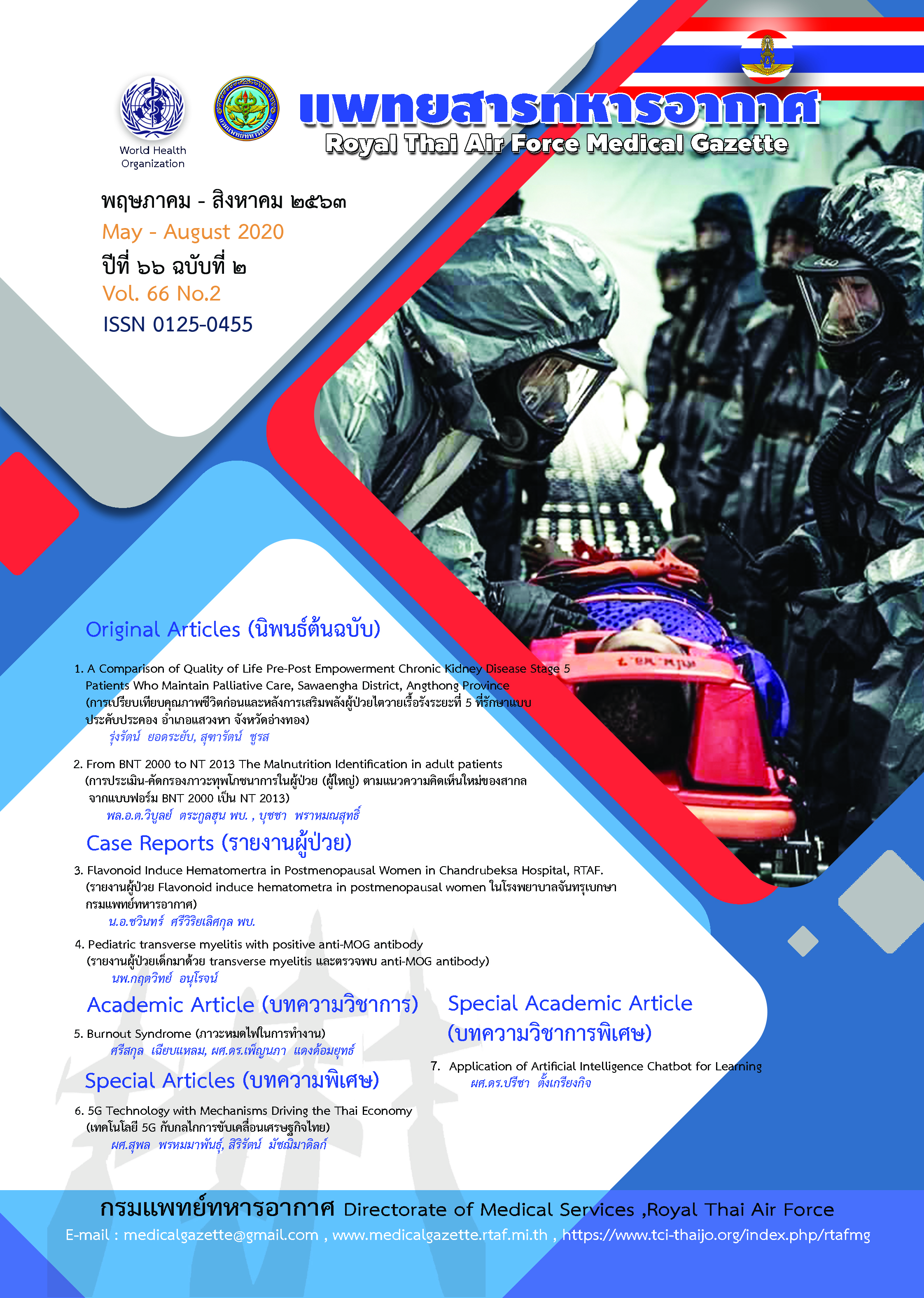Burnout Syndrome
Main Article Content
Abstract
Burnout syndrome is a state in which people got suppressed by pressure from long term hard work and anxiety. This sickness causes patients both physical and mental problems, showing 3 main symptoms such as; 1) Emotional fatigue and loss of mental energy, 2) Having a negative work performance and lack off a successful feeling concerning their job performance or field of work, 3) Having a negative view on their workplace relationship or feeling isolated from colleagues. The World Health Organization (WHO) has
classified burnout syndrome as a mental health problem that must be retained and categorized it into ICD10 (International Classification of Diseases). Burnout syndrome shows mental health warning signals in the form of sadness, depress, anger, unstable emotions and unsatisfaction in the workplace. Burnout syndrome also affects the patient’s thoughts such as having negative views on colleagues and work, paranoid, blaming the problem on others, doubting their individual work performance and trying to escape problems. Lastly, Burnout syndrome affects patients’ personal habits such as impulsive acts, inability to finish an assignment on time, having fewer pleasant activities, being late for work and having poor time management. They can perform self-evaluation by using the Maslach Burnout syndrome test. After they translated the score, they should check the results to see if their emotional fatigue and ignoring work rate are excessively high, which would show that they are suffering from Burnout syndrome. They should follow these steps to recover as soon as possible such as ; controlling stress, consider the pros and cons of quitting their job, finding the true objective of living, planning for their objective, and living their daily life with happiness.
Article Details

This work is licensed under a Creative Commons Attribution-NonCommercial-NoDerivatives 4.0 International License.
บทความที่ได้รับการตีพิมพฺเป็นลิขสิทธิ์ของวารสาร
References
2. สมาคมจิตแพทย์แห่งประเทศไทย. “หมดไฟ”.... “Burnout”. สืบค้นเมื่อวันที่ 25 กันยายน 2560. จาก https://www.facebook.com/
ThaiPsychiatric Association/photos/a.499791366791551. 1073741828.483246708446017/518490378254983/
3. จุฑารัตน์ แซ่ล้อ และสมใจ พุทธาพิทักษ์ผล. ปัจจัยที่มีอิทธิพลต่อความเหนื่อยหน่ายในงานของพยาบาลวิชาชีพ โรงพยาบาลสุราษฎร์ธานี. วารสารพยาบาล ตำรวจ. 2560;9(2):95-103.
4. Prior, R. Burnout is an official medical diagnosis, World Health Organization says.CNN update May 28, 2019.
5. กานต์ชนก แซ่อุ่ย และธีรวรรณ ธีระพงษ์. ปัจจัยพยากรณ์ภาวะหมดไฟในการทำงานของผู้ให้การปรึกษาในเขตภาคเหนือตอนบน.
วารสารจิตวิทยาคลินิก. กานต์ชนก แซ่อุ่ย และธีรวรรณ ธีระพงษ์. ปัจจัยพยากรณ์ภาวะหมดไฟในการทำงานของผู้ให้การ ปรึกษาในเขตภาคเหนือตอนบน. วารสารจิตวิทยาคลินิก. 2554;42(2):19-31.
6. วรัญญา วชิโรดม. หมดไฟ. สืบค้นเมื่อวันที่ 20 มกราคม 2554 จาก www.sksl.org
7. สายสัมพันธ์ จำปาทอง. ความสัมพันธ์ระหว่างการรับรู้ความสามารถของตนเอง คุณภาพชีวิตในการทำงานและความเหนื่อยหน่ายในการ
ทำงานของบุคลากรในโรงพยาบาลในกำกับของรัฐแห่งหนึ่ง. วิทยานิพนธ์ปริญญามหาบัณฑิต สาขาจิตวิทยาอุตสาหกรรมและ องค์การ ภาควิชาจิตวิทยา คณะศิลปศาสตร์ มหาวิทยาลัยธรรมศาสตร์. 2554.
8. บุญเอื้อ โจว. ปัจจัยที่มีอิทธิพลต่อความเหนื่อยหน่ายในการทำงานของพยาบาลวิชาชีพ: ศึกษากรณีวิทยาลัย แพทยศาสตร์
กรุงเทพมหานครและวชิรพยาบาล. สารนิพนธ์ปริญญามหาบัณฑิตคณะพัฒนาสังคมและสิ่งแวดล้อม สถาบันบัณฑิตพัฒนบริหารศาสตร์. 2553.
9. วัลลภ วิชาญเจริญสุข และสุนทร ศุภพงษ์. ภาวะหมดไฟในการทำงานและปัจจัยที่เกี่ยวข้องในผู้แทนยา บริษัทยาข้ามชาติ. ธรรมศาสตร์เวชสาร. 2558;152:225-31.
10. Maslach C, Jackson, S. E. The measurement of experienced burnout. J Occup Behav. 1981;2:99-113.
11. Miller, L. H., Smith, A. D., & Rothstein, L. The stress solution: An action plan to manage the stress in your life. New York: Pocket Books. 1993.
12. ชลธิชา แก้วอนุชิต. สุขภาพจิตชุมชน.กรุงเทพฯ: บริษัท โอ เอส พริ้นติ้งเฮ้าส์จำกัด. 2561.
13. สุวนีย์ เกี่ยวกิ่งแก้ว. การพยาบาลจิตเวช. กรุงเทพฯ : โรงพิมพ์มหาวิทยาลัยธรรมศาสตร์. 2554.
14. พรศิริ นีลปัทมานนท์ และศิริวรรณ ทวีวัฒนปรีชา. The Satir Model. กรุงเทพฯ: ห้างหุ้นส่วนจำกัด เฟรม-อัพ-ดีไซน์. 2557.
15. วาทินี สุขมาก. การพยาบาลสุขภาพจิตและจิตสังคม 1. กรุงเทพฯ: สำนักพิมพ์มหาวิทยาลัยมหาสารคาม. 2556.
16. กาญจน์สุนภัส บาลทิพย์,อุษณีย์ เพชรรัชตะชาติ, ศิริวรรณ พิริยคุณธร, นฤมล ติระพัฒน์ และปราณี เลี่ยมพุทธทอง. การพัฒนา
รูปแบบการใช้แนวคิดเป้าหมายในชีวิตและปรัชญาของเศรษฐกิจพอเพียงเพื่อการสร้างเสริมสุขภาพแบบองค์รวมของวัยรุ่นไทย. วารสารพยาบาลสงขลานครินทร์. 2559;36(3):111-30.
17. มุกข์ดา ผดุงยาม. การพยาบาลสุขภาพจิตและจิตเวชศาสตร์. กรุงเทพฯ: บริษัทนีโอดิจิตอล จำกัด. 2561.
18. Smith, M., Segal, J., & Robinson, L. Burnout Prevention and Treatment. สืบค้นเมื่อวันที่ 15 พฤศจิกายน 2562. จาก https://www.helpguide.org/articles/stress/burnout-prevention-and-recovery.htm


